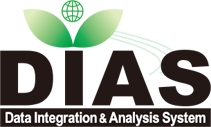


  |  |

| Name | Japanese Reanalysis for Three Quarters of a Century with COBE-SST2 |
| Abbreviation | JRA-3Q-COBE |
| DOI | doi:10.20783/DIAS.661 |
| Metadata Identifier | JRA3Q_COBE20251203090020-DIAS20221121113753-en |
| Name | Numerical Prediction Division, Information Infrastructure Department |
|---|---|
| Organization | Japan Meteorological Agency |
| Address | 3-6-9 Toranomon, Minato City, Tokyo, 105-8431, Japan |
| jra@met.kishou.go.jp |
| Name | DIAS Office |
|---|---|
| Organization | Japan Agency for Marine-Earth Science and Technology |
| Address | 3173-25, Showa-Cho, Kanazawa-ku, Yokohama-shi, Kanagawa, 236-0001, Japan |
| dias-office@diasjp.net |
| Name | Numerical Prediction Division, Information Infrastructure Department |
|---|---|
| Organization | Japan Meteorological Agency |
| Name | Numerical Prediction Division, Information Infrastructure Department |
|---|---|
| Organization | Japan Meteorological Agency |
publication : 2023-08-10
The Japan Meteorological Agency produced a sub-product of the Japanese Reanalysis for Three Quarters of a Century (JRA-3Q) using the sea surface temperature (SST) from the Centennial In Situ Observation-based Estimates of the Variability of SSTs and Marine Meteorological Variables Version 2 (COBE-SST2) as the lower boundary condition for the period from June 1985 to December 1990. In JRA-3Q, the SST specified as the lower boundary condition is COBE-SST2 with a resolution of 1° based on in situ observations until May 1985 and the Merged Satellite and In-Situ Data Global Daily Sea Surface Temperature (MGDSST) with a resolution of 0.25° based on satellite observations since June 1985. This sub-product, called JRA-3Q with COBE-SST2 (JRA-3Q-COBE), was produced in order to enable evaluation of changes in product characteristics following the switch from COBE-SST2 to MGDSST.
climatologyMeteorologyAtmosphere
| Begin Date | 1985-06-01 |
| End Date | 1990-12-31 |
| North bound latitude | 90 |
| West bound longitude | -180 |
| Eastbound longitude | 180 |
| South bound latitude | -90 |
| Dimension Name | Dimension Size (slice number of the dimension) | Resolution Unit |
|---|---|---|
| row | 40 (km) | |
| column | 480 | 40 (km) |
| vertical | 100 | 0.02-25 (hPa) |
| Keyword Type | Keyword | Keyword thesaurus Name |
|---|---|---|
| theme | Atmosphere | GCMD_science |
| theme | Aircraft, Balloons/Rockets, Earth Observation Satellites, In Situ Land-based Platforms, In Situ Ocean-based Platforms, Models > , Navigation Platforms | GCMD_platform |
| theme | Climate, Weather | GEOSS |
| Keyword Type | Keyword | Keyword thesaurus Name |
|---|---|---|
| theme | DIAS > Data Integration and Analysis System | No_Dictionary |
JRA project website : https://www.data.jma.go.jp/jra/html/
JRA-3Q Data Format (in English) : https://www.data.jma.go.jp/jra/html/JRA-3Q/index_en.html#FORMAT
JRA-3Q Data Format (in Japanese) : https://www.data.jma.go.jp/jra/html/JRA-3Q/index_ja.html#FORMAT
Quality issues (in English) : https://www.data.jma.go.jp/jra/html/JRA-3Q/index_en.html#QUALITY
Quality issues (in Japanese) : https://www.data.jma.go.jp/jra/html/JRA-3Q/index_ja.html#QUALITY
file download : https://data.diasjp.net/dl/storages/filelist/dataset:661
| name | version | specification |
|---|---|---|
| GRIB | 2 |
Disclaimer
Please note that although JMA has paid the closest attention to produce the Products, JMA assumes no responsibility regarding the reliability of the Products. JMA is not responsible to you for any damage that may be caused by the use of the Products on this site.
If data provider does not have data policy, DIAS Terms of Service (https://diasjp.net/en/terms/) and DIAS Privacy Policy (https://diasjp.net/en/privacy/) apply.
If there is a conflict between DIAS Terms of Service and data provider's policy, the data provider's policy shall prevail.
 CC-BY-NC-SA 4.0 :
Creative Commons Attribution-NonCommercial-ShareAlike 4.0 International
CC-BY-NC-SA 4.0 :
Creative Commons Attribution-NonCommercial-ShareAlike 4.0 International
JRA-3Q-COBE data should be acknowledged in scientific and technical reports.
Example
"This report references JRA-3Q-COBE reanalysis data from the Japan Meteorological Agency."
If you plan to use this dataset for a conference presentation, paper, journal article, or report etc., please include acknowledgments referred to following examples. If the data provider describes examples of acknowledgments, include them as well.
" In this study, [Name of Dataset] provided by [Name of Data Provider] was utilized. This dataset was also collected and provided under the Data Integration and Analysis System (DIAS), which was developed and operated by a project supported by the Ministry of Education, Culture, Sports, Science and Technology. "
Kosaka, Y., S. Kobayashi, Y. Harada, C. Kobayashi, H. Naoe, K. Yoshimoto, M. Harada, N. Goto, J. Chiba, K. Miyaoka, R. Sekiguchi, M. Deushi, H. Kamahori, T. Nakaegawa, T. Y. Tanaka, T. Tokuhiro, Y. Sato, Y. Matsushita, and K. Onogi, 2024: The JRA-3Q reanalysis. J. Meteor. Soc. Japan, 102, 49-109, https://doi.org/10.2151/jmsj.2024-004.